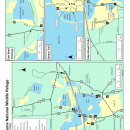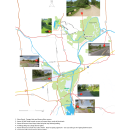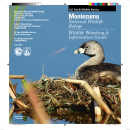Visit Us
National wildlife refuges offer us all a chance to unplug from the stresses of daily life and reconnect with our natural surroundings. Montezuma NWR, in the Finger Lakes region of New York State, is a globally renowned place for birding and nature photography. There are several ways to enjoy the refuge: view displays and get information from our volunteers at the visitor center; take the 3-mile Wildlife Drive auto tour route; walk nature trails of various lengths and difficulty; gain a different perspective from viewing towers and platforms; fish from the refuge into state-owned waters; hunt various species during New York State hunting seasons. You can also follow the cell phone tour provided by the Friends of the Montezuma Wetlands Complex. Check it out here!
While most visitors to the refuge only take advantage of the Visitor Center and the Wildlife Drive, there is so much more for you to experience while you’re here! Montezuma's Wild Things Scavenger Hunt can help you discover the refuge's visitor areas and cool things to see here. Pick up a copy at the Visitor Center or find it here!
Start at the Visitor Center, where you can find maps, brochures, and information about which birds are being seen on the refuge and where. Volunteers at the information desk can help orient you to the refuge and to current hot spots for viewing, but if the Visitor Center is closed when you visit, information is always available in the attached sun room, and restrooms can be accessed from the parking lot near the big heron sculpture.
From the Visitor Center parking area, you can walk the Seneca Trail (this trail is shared with late season deer hunters; go here for season information), taking advantage of the viewing tower to look out over the Main Pool. NOTE: Much of the Seneca Trail is from January 1 through September 30 in accordance with New York State regulations for bald eagle protection. Also beginning from the Visitor Center parking area is the Wildlife Drive (vehicles only; no bicycles or pedestrians; open April 1 through November 30). This is the refuge’s most popular attraction. You will drive one-way along the edge of the Main Pool. Depending on the season, you will get the chance to see ducks and geese, marsh birds (heron, pied-billed grebes, black tern, gallinule, bittern, and more), shorebirds, bald eagles, osprey, northern harrier, and possibly muskrat, fox, mink, beaver, raccoon, and deer. Be sure to stay in your car along the Wildlife Drive. Your car acts like a blind, helping you observe wildlife without disturbing them or scaring them away. By staying in your car, you help wildlife conserve energy for survival.
The Wildlife Drive ends on State Route 89, from which you can access other viewing areas (North Spring Pool, Tschache Pool, May’s Point Pool, Knox-Marselluls Overlook) and more walking trails (South Spring Pool and Esker Brook Trails; note annual trail closure November 1 through January 1 to non-hunters). Taking Route NY-89 north will bring you to Savannah, NY, where you can visit the refuge’s Sandhill Crane Unit, as well as the Montezuma Audubon Center and the Northern Montezuma Wildlife Management Area (owned by the New York State Department of Conservation).
Activities
The Montezuma NWR is truly a haven for wildlife. Its diverse habitats of wetland, grassland, shrubland and forest give food, shelter, water and space to many of Central New York’s wildlife species. Waterfowl and other migratory birds depend on the Refuge as nesting, feeding, breeding and stopover grounds. Some make the refuge a home year-round.
Wildlife comes first on all National Wildlife Refuges. However, Montezuma can also provide wildlife dependent opportunities to you, the public—like the nature trails, observation towers and decks, and the Wildlife Drive. Opportunities to enjoy the refuge vary to encompass the interests of a diverse visitor base. We hope you enjoy YOUR visit!
NOTE: The Wildlife Drive and Visitor Center are open daily April 1 through November 30 each year. Esker Brook and South Spring Pool Trails close annually November 1 through January 1. Seneca Trail is closed January 1 through September 30 in accordance with New York State regulations for bald eagle protection.
Trails
Refuge trails, viewing towers and platforms, overlooks, and kiosks provide family-friendly wildlife viewing areas and information. The refuge is relatively flat, so all trails have very little elevation-gain, offering easy walks without losing any of the nature-experience opportunities. Pick up a map at the Visitor Center.
Notable Trail Information: The Seneca Trail is shared with hunters during the New York State late bowhunting season and is closed January 1 through September 30 in accordance with New York State regulations for bald eagle protection. The Esker Brook and South Spring Pool Trails are closed November 1 through January 1.
Related Documents
Rules and Policies
As you visit, please keep in mind that you are a guest here. The habitats we manage are homes to several species of birds and other wildlife. We provide their houses, food stores, breeding grounds, and rest areas. You can be a welcome guest by following a few simple guidelines and setting an example for those who are not “in the know”!
Please DO:
- Visit from ½ hour before sunrise to ½ hour after sunset.
- Stay on designated refuge trails and at designated refuge viewing areas.
- Stay in your car along the Wildlife Drive until you reach designated viewing areas marked with a brown and white binocular sign. At viewing areas, stay with your car and on the trail.
- Walk your dog on a leash on the Seneca Trail (when open) and Refuge entrance road only.
- Fish only in designated areas.
- Observe information and orientation signs.
Please DO NOT:
- Leave designated trails, walk on dikes, enter into water/Refuge pools, enter into closed areas.
- Go beyond closed gates, barricades, or area closed signs.
- Jog/Run anywhere on the refuge.
- Bicycle anywhere on the refuge.
- Camp, have fires, or stay overnight on any part of the Refuge.
- Collect any materials (feathers, plants, rocks, animals, etc.) from the Refuge.
- Park on the Wildlife Drive and then take a walk along the Drive.
- Fish or boat in Refuge pools and other waters. You may fish and boat in the canals and rivers around the Refuge from designated fishing and launching areas.
- Feed wildlife.
- Fly drones.
- Walk your dog, except on the Seneca Trail and Refuge entrance road.
Locations



















Montezuma National Wildlife refuge provides resting, feeding, and nesting habitat for waterfowl and other migratory birds. Montezuma is situated in the middle of one of the most active flight lanes in the Atlantic Flyway. The refuge is located at the north end of Cayuga Lake in the Finger Lakes Region of New York State. The refuge contains about 10,000 acres and is situated in Seneca, Wayne, and Cayuga Counties. The refuge is 35 miles (56 km) west of Syracuse, 40 miles (64 km) north of Ithaca, and 45 miles (72 km) east of Rochester.
The refuge's Visitor Center, entrance to the Wildlife Drive and Seneca Trail, and the refuge’s headquarters office are located at 3395 U.S. Route 20 East, Seneca Falls, NY, 13148, between Auburn and Seneca Falls, NY.
From the New York State Thruway (Interstate 90), take exit 41. Turn right (south) onto NY-414 and follow approximately 200 yards to the traffic light. Turn left (east) at the light onto NY-318 and follow for approximately 5 miles to the end, where NY-318 meets NY-5/US-20 and NY-89. Turn left (east) onto NY-5/US-20 and follow for 1.25 miles. Turn left into the refuge entrance.





